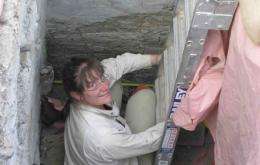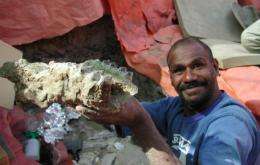From the field: Bush tucker feeds an ancient mystery

(Phys.org) -- As sabre tooth tigers and woolly mammoths were wandering around Europe, unique, giant prehistoric animals were living in Australia – three metre tall kangaroos and wombat-like creatures, the size of a four-wheel drive, were just some of the curious creatures Down Under. Yet mysteriously, sometime during the last 100,000 years, they disappeared forever.
The extinction of these giant animals, known as megafauna, has generated great debate. One group advocates “human blitzkrieg” – those asserting the first Australians hunted these beasts to extinction. Others, myself included, find there is too little evidence to confidently attribute responsibility to any particular factor. Nonetheless, climatic instability during the last ice age cannot be discounted.
Adding to the difficulty in settling the debate is the lack of fossil records – one of the characteristics of the dry Australian continent. However, there is just one place in Australia where the fossils of megafauna are found alongside concurrent evidence of human activity: Cuddie Springs, an ancient lake near Brewarrina in north-western New South Wales. A giant flightless bird called Genyornis, the giant wombat-like Diprotodon, Komodo-sized goannas and three metre tall kangaroos are just a few of the animals identified here.

Over the past 20 years I have led a team of researchers in excavating the Cuddie Springs deposits to try to unravel the relationship between the stone tools and the fossil bones – answering questions about how they came to be preserved together. Indigenous collaboration has been an important aspect of the work at Cuddie Springs. Members of the Brewarrina and Walgett Aboriginal communities have been trained in archaeological excavation techniques as part of the project.
For two of our Indigenous colleagues – Brett Cochrane and Chris Boney – involvement in the research has heightened their concern that the bush skills taught to them by elders past should not be lost. To this end we, along with archaeozoologist Dr Jillian Garvey, developed a project that documented Indigenous emu butchering skills while also enhancing our understanding of the fossil record. By using the emu as an analogue of its forebear, Genyornis, we can better understand how important it might have been to Pleistocene Australians.
During a recent expedition, Brett and Chris obtained two emus – one for traditional butchering and the second for scientific dissection. Jillian recorded which parts were discarded during butchering while every organ was weighed and measured. Some samples were submitted for nutritional analysis.
The emu legs yielded nearly 14 kilograms of meat, and when extrapolated to the much-larger Genyornis, this translates to 85 kilograms of food. A Genyornis drumstick was not a take-away, but was likely carved up for steaks, a revelation supported by the presence of butchering tools alongside the bones.
Nonetheless, investigations at Cuddie Springs have shown us that Aborigines enjoyed a broad dietary base. There is no evidence that they specifically targeted megafauna. In fact, with a decline of megafauna coinciding with deteriorating climatic conditions during the height of the last ice age, people switched to grinding grass seeds and hunting more-abundant prey animals. It would appear unlikely that humans were solely responsible for the extinctions.
Regardless of how our findings impact on the acrimonious debates over who or what killed the megafauna, the outcomes in learning, knowledge and understanding from this project have been empowering for all involved.
Provided by University of New South Wales



















